Cool-Season Annuals
Enjoy these pretty, easy-to-grow flowers when the temperatures are brisk
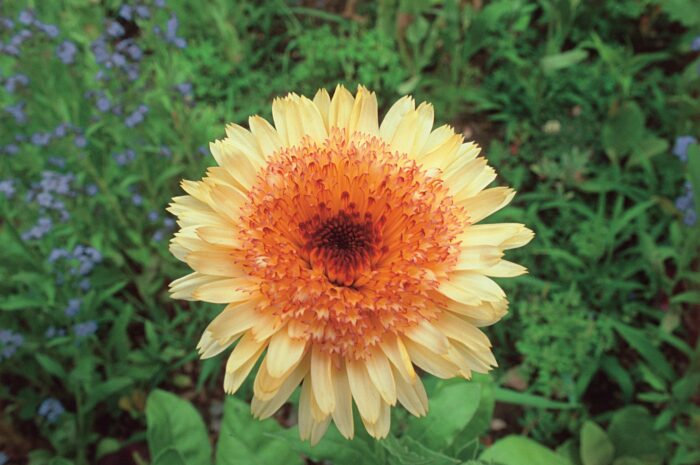
When I first started gardening, I was long on ambition and plant lust, but woefully short on cash. It didn’t take me long to figure out that I could quench my desire for new flowers easily and inexpensively by starting them from seed. And although my garden has grown bigger since then and it’s harder and harder to squeeze in new finds, I’m still hooked on searching through the seed catalogs each winter for new plants to try. Over the years, I’ve built up a repertoire of flowers I love to grow from seed because they are beautiful and often fragrant and because caring for them extends the gardening season from winter until the crisp days of autumn.
Many of my favorites are cool-season annuals—flowers defined loosely as such by these characteristics: First and foremost they relish cool temperatures, growing best in spring or fall, or where summers are moderate; many are frost tolerant to a certain point; and others require a chilling period for their seeds to germinate and are best sown outdoors when temperatures are brisk.
Part of the allure in growing many of these delightful flowers is their rich history. Many cool-season annuals have been grown since ancient times and are steeped in folklore. Calendula (Calendula officinalis), for example, was grown by the Romans and deemed an herb of the gods. In Old England, the sunny yellow flowers were called pot marigolds because the blossoms were often used to flavor soups.
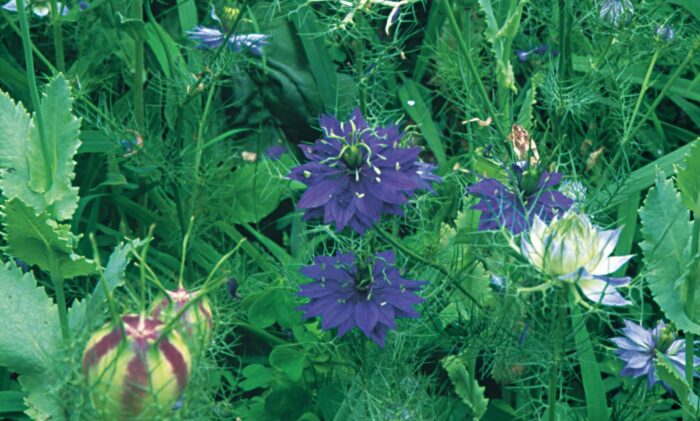
Other cool season annuals are truly pass-along plants, handed down from one generation to another, or ex-changed between gardening friends. My first poppy (Papaver somniferum) seeds came from Thelma Crawford of Wellsville, Kansas, who kindly sent me a package of her mixed poppy seeds after I read about her seed saving efforts and wrote her a letter. At 86 years of age, Thelma is still growing her poppies and told me she’d send me some more if I ever run out. Now I also grow a strain called ‘Lauren’s Grape’, given to me by good friend and colleague Steve Silk, who in turn got seeds originally from Colorado gardener Lauren Springer.
I also discovered some of my favorite cool-season annuals by visiting a restored garden designed by Gertrude Jekyll at the Glebe House in nearby Woodbury, Connecticut. Though my first visit to the garden was after its June peak, I was enthralled by large clumps of salmon-colored snapdragons (Antirrhinum majus) planted between peonies, and airy sprays of love-in-a-mist (Nigella damascena). Though Jekyll’s mixed borders are beyond my means and desires, I like growing some of the annuals she relied on in her designs to provide color throughout the gardening season.
Fragrance that rivals the sweetest perfume
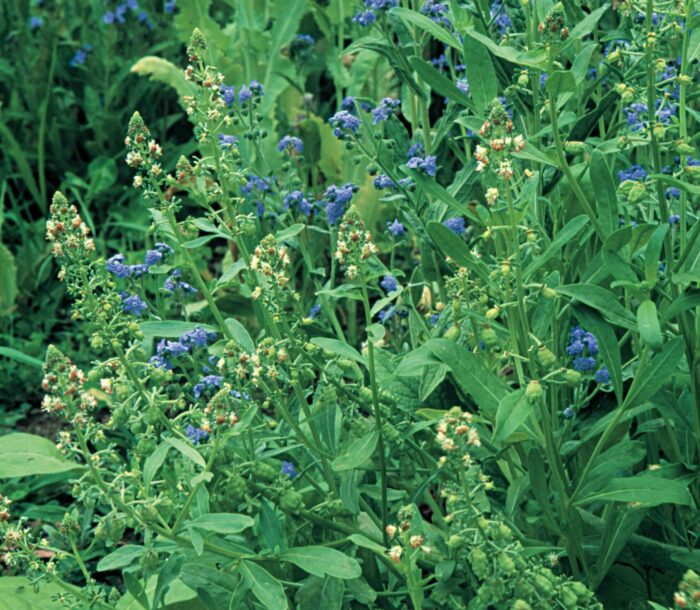
Some of the loveliest, freshest scents in the garden come from cool-season annuals. No garden should be without easy-to-grow sweet alyssum (Lobularia maritima). Its dainty white flowers have a honey fragrance that’s as attractive to insects as it is to gardeners. In fact, sweet alyssum is an important nectar plant for beneficial insects like lacewings and lady beetles. The low-growing plants are perfectly at home at the edge of a bed or cascading out of pots. Happily, sweet alyssum is one of those plants that perpetuates itself readily.
Mignonette (Reseda odorata) was an old-fashioned, fragrant favorite of Gertrude Jekyll. Its flowers are not at all showy, but the fresh perfume they emit made them a mainstay of Victorian gardens, where they were often grown in pots to raise the diminutive 10-inch plants up to nose level.
Sweet Annie (Artemisia annua) grows to 6 feet tall with soft, feathery, bright-green foliage that is sweetly fragrant when brushed. I first encountered sweet Annie at Caprilands Herb Farm in Coventry, Connecticut. There it formed a willowy, informal hedge in the garden, and indoors renowned herb gardener and writer Adelma Simmons used it lavishly, as our colonial ancestors did, in dried arrangements and hung from ceilings to freshen the air. Crush the leaves of sweet Annie and hold them up to your nose and you’ll find the sweetness enhanced by camphor—an obvious giveaway to the plant’s Artemisia pedigree. Sweet Annie is reputed to have weedy tendencies, but it has never self-sown aggressively in my garden, and volunteers from season to season have always been a welcome surprise.
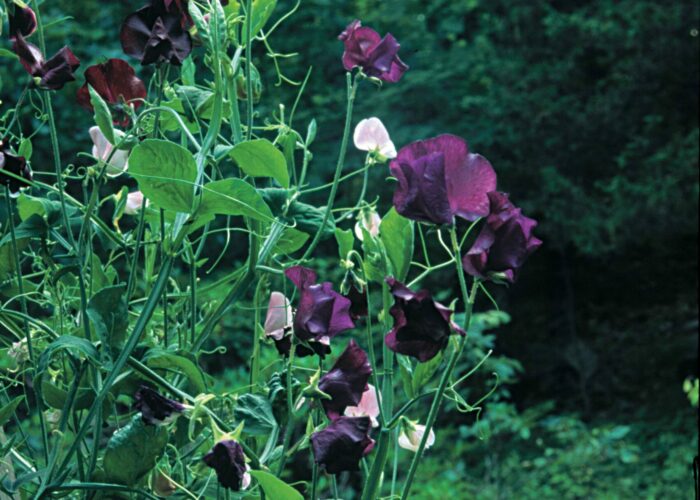
The luxuriant color and sensual blossoms of annual sweet peas (Lathyrus odoratus) tugged at my heartstrings the first time I laid eyes on them in a glossy gardening magazine (photo right). And ah, their fragrance—it is one of the loveliest scents on earth, rivaling that of lilacs and old roses. For a few years, success in growing sweet peas eluded me as I tried to fulfill a vision of them scrambling up bamboo tepees crammed into crowded perennial beds. Once I gave them a sizable space of their own, up a large trellis in a sunny, manure-laden bed set aside for vegetables, my sweet peas thrived.
It’s vital to get sweet peas in the ground early—they relish the cool temperatures of early spring and need time to settle in before warmer days arrive and they begin to scramble skyward. Though they can be direct-sown, I prefer to start sweet pea seeds indoors under lights in peat pots in mid-March. This gives the plants a good, healthy start. Once they’re hardened off, I set them out in the garden when they’re 4 or 5 inches tall. Just be sure to remove the uppermost edge of the peat pot when you plant the seedlings, as the exposed peat will wick moisture away from the plants if exposed to the air. Once sweet peas begin to bloom, pick the flowers often to encourage more bloom and fill your house with the fragrant bouquets.
True blue and a multitude of other colors too
Texture, foliage, form, and shape are all admirable qualities in plants. But no gardener can deny the thrill that only a blast of flower color delivers, and there is no quicker route to a dose of color in the garden than planting annuals. Cool-season annuals offer flowers in the truest blues, sultry reds, cheerful yellows, and every color in between, thanks to the hybridizer’s art.
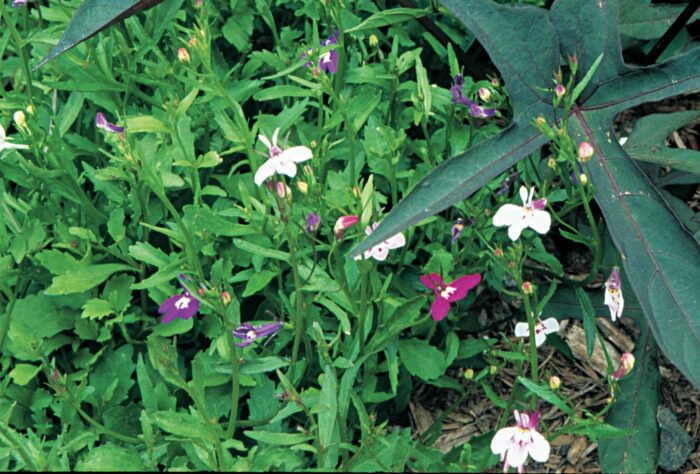
Get clear, clean, crisp blue that is not muddied with purple by growing cornflowers (Centaurea cyanus), love-in-a-mist, and Chinese forget-me-not (Cynoglossum amabile). And though technically classified as a hardy biennial, forget-me-not (Myosotis sylvatica) will bloom true blue in spring with daffodils if started from seed indoors in January.
Every year I start a full flat of annual lobelia (Lobelia erinus) because the seeds are inexpensive and the tiny flowers look better en masse. Annual lobelia is available in a multitude of blue and lilac shades, but my favorite is ‘Crystal Palace’, which has dark-blue flowers and deep-bronze foliage. Then there is the glaucous blue foliage of Cerinthe major ‘Purpurascens’, joined by purple-blue, bell-shaped flowers in summer. Growing best in areas with cool summers, this plant is best started indoors and then planted out after the last frost.
Pansies (Viola × wittrockiana) come in a literal rainbow of colors, from pale blue and antique rose to vibrant orange and even black. I’ve been growing black pansies since they came on the scene a few years ago—there is something about the rich, sober shades of purple and red veering toward black that is completely refreshing amid the cheerful greens and yellows of springtime. The dark blooms look lovely near emerging chartreuse hosta foliage and burgundy Heuchera leaves.

Old-fashioned snapdragons come in every color except blue. The heirloom ‘Black Prince’ has deep crimson flowers, bronze foliage, and red stems. One year I grew ‘Jamaican Mist’ snapdragons that bloomed in mixed shades of soft yellow, rose, and peach near the like colored English shrub roses ‘Abraham Darby’ and ‘Graham Thomas’. Painted tongue (Salpiglossis sinuata) produces richly colored flowers in purple, red, and orange that are funnel-shaped and heavily veined. Started indoors and planted out when temperatures are still cool, painted tongue combines well with daylilies (Hemerocallis cvs.), whose arching foliage will provide some support for their 2-foot flower stalks.
Growing annuals from seed is an easy way to experiment with color, and the seed catalogs offer tempting choices. Yes, you can grow the standard bright orange California poppies (Eschscholzia californica) (photo right), but thanks to the work of plant breeders, there is also ‘Apricot Flambeau’, ‘Silver Almond’, ‘Milky White’, and even a purple-flowered form from which to choose. Larkspur (Consolida ajacis) is available in jewel tones of blue, purple, and pink, but last year I couldn’t resist trying a new variety named ‘Earl Grey’ that promised silvery mauve blossoms on 4-foot stems.
Direct sow or start seeds early indoors
There are many annuals, like poppies and love-in-a-mist, that should be direct-sown in the garden because the seeds need a period of cold to germinate and because their seedlings resent transplanting. Along with the poppy seeds, Thelma Crawford sent me planting instructions that I follow faithfully: While it is still very cool in early spring, loosen soil with a rake, broadcast the seed, rake again but don’t cover the seed, sprinkle or let rain settle the seeds, keep the soil moist. It’s worked like a charm every year.
If I lived in the South, I would sow seeds in the fall and follow the advice given to Elizabeth Lawrence by her friend Mr. Tong, as she relayed in A Southern Garden: “Mr. Tong always said that seeds should be sown in September or November, never in October. September seeds get a good start, and can take care of themselves; November seeds stay in the ground all winter and come up in the spring; but October seeds come up too late to get hardened before cold weather, and they are apt to be killed.” Even in northern gardens, some seeds, like larkspur, do better if direct-sown in the fall.
Other cool-season annuals are best started indoors under lights. Since many of them, like pansies, forget-me-nots, and painted tongue, can take some frost, it’s not too early to get them started in late January and early February so they can be hardened off and planted out in early spring. Seeds have different requirements for germination—pansies need darkness, so I cover their flats with black plastic; snapdragon seeds need light to germinate, so I don’t cover them with soil. If you become interested in starting a lot of plants from seed, I highly recommend buying a good seed-starting reference book, like The Seed Starters Handbook by Nancy Bubel or From Seed to Bloom by Eileen Powell.
No matter where you live, the key to growing any of these cool-season annuals is to plant them when the time is right in your area. In the arid climate of Tucson, Arizona, my sister-in-law Judy sows sweet pea seeds in September with her kindergarten class. They bloom in April and May, and the children are rewarded with armloads of blossoms for Mother’s Day bouquets.
PLANTS
A Sampling of Cool-Season Annuals
This list is by no means inclusive of all annuals that thrive in cool temperatures, but it offers a good selection of colorful, fragrant, easy-to-grow flowers. Consult seed catalogs for other choices and don’t be afraid to experiment. Where links are provided below, you can learn more about the plant in Fine Gardening‘s Plant Guide.
Calendula (Calendula officinalis)
Direct-sow or start indoors 6 to 8 weeks before last frost. Frost-tolerant; ‘Kablouna Mixed’ produces orange, lemon, and apricot flowers with dark centers.
California poppy (Eschscholzia californica)
Direct-sow. Frost-tolerant; thrives in cool climates.
Cerinthe major ‘Purpurascens’
Start indoors 6 weeks before last frost. Thrives in cool climates; may be perennial in warm zones.
Chinese forget-me-not (Cynoglossum amabile)
Direct-sow. Blue flowers in midsummer.
Cornflower (Centaurea cyanus)
Direct-sow. Blue flowers; ‘Black Ball’ has deep-purple flowers.
Forget-me-not (Myosotis sylvatica)
Sow indoors 4 to 6 weeks before planting out in early spring. Biennial that will flower in the first year if started early.
Larkspur (Consolida ajacis)
Direct-sow in fall. Thrives in cool climates; blue, purple, pink, and white flowers
Lobelia (Lobelia erinus)
Start indoors 10 to 12 weeks before last frost. Deep blue or lilac flowers; ‘Crystal Palace’ has bronze foliage
Love-in-a-mist (Nigella damascena)
Direct-sow. ‘Miss Jekyll’ has bright blue flowers; ‘Persian Jewels’ is a mix of blue, mauvy-pink, and white.
Mignonette (Reseda odorata)
Sow indoors 6 to 8 weeks before last frost; seeds need light to germinate. Frost-tolerant; fragrant flowers.
Nasturtium (Tropaeolum majus)
Direct-sow or start indoors in peat pots 2 to 4 weeks before last frost. Frost-tolerant; plants thrive where summers are cool.
Opium poppy (Papaver somniferum)
Direct-sow. Flowers in shades of pink, purple, red, and white in single, double, and semi-double forms.
Pansy (Viola × wittrockiana)
Start in late fall in a cold frame, or 8 to 10 weeks before planting out. Plants can survive late frost in spring, early frost in fall; deadhead to prolong blooming.
Painted tongue (Salpiglossis sinuata)
Start indoors 8 to 10 weeks before last frost; seeds need darkness to germinate. Plants thrive in cool temperatures; may need staking.
Shirley poppy (Papaver rhoeas)
Direct-sow. ‘Mother of Pearl’ has luminescent flowers in pastel shades.
Snapdragon (Antirrhinum majus)
Start indoors 6 to 8 weeks before last frost. ‘Black Prince’ has crimson flowers and bronze foliage; plants may be perennial in mild winter areas.
Sweet alyssum (Lobularia maritima)
Direct-sow. Fragrant flowers produce nectar for beneficial insects.
Sweet Annie (Artemisia annua)
Direct-sow. Frost-tolerant; fragrant foliage.
Sweet peas (Lathyrus odoratus)
Direct-sow in early spring or start indoors in peat pots. Climbs to 6 feet, so provide a trellis for support; select varieties for fragrant blooms.
Fine Gardening Recommended Products

Lee Valley Garden Knife
Fine Gardening receives a commission for items purchased through links on this site, including Amazon Associates and other affiliate advertising programs.

Johnny’s Selected Seeds Connecta® Cultivation Kit
Fine Gardening receives a commission for items purchased through links on this site, including Amazon Associates and other affiliate advertising programs.

Gardener's Supply Company Summerweight Fabric Plant Cover
Fine Gardening receives a commission for items purchased through links on this site, including Amazon Associates and other affiliate advertising programs.








Comments
Log in or create an account to post a comment.
Sign up Log in